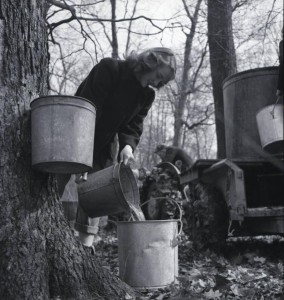Tree Tapping and Sugar Shacks: Maple Syrup in Ohio


Around Ohio, this time of year marks an important season for a delicious natural resource that many of us enjoy–maple syrup! With harsh and long-lasting winters over the last few years, syrup production has not been at its peak, but a milder winter this year promises plenty of fantastic opportunities to explore Ohio’s maple syrup heritage. In the meantime, why not check out the historic materials on Ohio Memory that explore this interesting process?
According to the Maple Syrup Program of Ohio State University’s Extension Office, Ohio averages out as the 4th largest producer of maple syrup in the country, with around 900 producers. Our state is home to about half a dozen native maple species, and while all of these can be tapped for maple sap, it is three–the sugar maple, black maple and red maple–that generate the majority of commercial sap for syrup production. It takes an average of 40 gallons of maple sap to produce a single gallon of syrup, concentrating the 2-3% sugar content naturally found in maple sap to the 66-69% sugar content of maple syrup.

The traditional process for creating maple syrup, long used by Ohioans, involves tapping the maple tree in late winter, when daytime temperatures begin to warm but nighttime still brings freezing digits. A small metal spout called a spile is driven into the tree, which allows the sap to freely drip into a suspended bucket or other container. Over the course of the season, sap is regularly collected and processed in batches. This “run” usually ends around early March, prior to the maple’s springtime budding which will turn the flavor of the resulting syrup. Processing the syrup involves heating the sap in a pan and boiling off most of its moisture. This evaporation step can take quite a while, and was often either performed outside or in a dedicated building called a “sugar shack” or sugar house. For a more detailed look at how to collect sap and make syrup, check out this fact sheet.
Maple syrup’s history in the state dates far before the era of European settlement–the American Indians in what would later become Ohio had a long tradition of gathering and boiling down the sweet substance. Maple syrup even ties into Ohio’s abolitionist past, as antislavery activists in the state used maple sugar (created from further processing of maple syrup) during the Civil War in protest of the cane sugar produced by slaves in the South.
We hope you have a chance to get out this season and learn more about maple syrup and its history in Ohio, either through the many events scheduled around the state, or perhaps through the Maple Madness Driving Trail with 45 stops in 22 counties. But if not, at least you can get a “taste” on Ohio Memory!
Thanks to Lily Birkhimer, Digital Projects Coordinator at the Ohio History Connection, for this week’s post!



Leave a Reply
You must be logged in to post a comment.